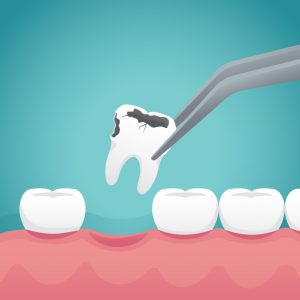What to Expect & How to Prepare for a Tooth Extraction Procedure at Perrott Dentistry

If you’re considering a tooth extraction in Boardman, Austintown, Struthers, Campbell or nearby areas, Dr. Perrot provides quality care to ensure a smooth and stress-free experience. Contact our Boardman dental office by calling (330) 726-0090 and one of our team members will walk you through the entire tooth extraction process, from preparation to recovery, so you can feel confident about your treatment.
When Is a Tooth Extraction Necessary?
There are several reasons why a dentist may recommend extracting a tooth, including:
Severe Tooth Decay
When a cavity extends too deep into a tooth, it can reach the pulp (the inner part containing nerves and blood vessels). If the infection is too extensive for a root canal to fix, an extraction may be the best option to prevent further complications.
Advanced Gum Disease
Periodontal disease can weaken the bones supporting your teeth, making them loose. In cases where gum disease has severely damaged a tooth, extraction may be necessary to maintain overall oral health.
Impacted or Overcrowded Teeth
Wisdom teeth are the most common teeth to become impacted, meaning they don’t have enough room to emerge properly. Overcrowding can also be an issue, particularly for those undergoing orthodontic treatment. Removing a problematic tooth can create space for proper alignment.
Dental Trauma
If a tooth is severely broken or fractured beyond repair due to an accident or injury, extraction may be the only solution to prevent infection or further damage.
Preparing for Dentures or Implants
In some cases, a tooth may need to be removed to make way for dentures or dental implants, ensuring a secure and comfortable fit.
If you’re in Boardman, Poland, Canfield or nearby areas, Dr. Perrott can assess your oral health and determine if an extraction is necessary.
How to Prepare for a Tooth Extraction at Perrott Dentistry
Before undergoing a tooth extraction, your dentist will provide you with essential instructions to ensure a smooth procedure. Here’s what you can expect before the appointment:
Consultation & Examination
During your consultation, Dr. Perrott will examine your tooth and may take X-rays to evaluate its condition and position. This helps determine whether a simple or surgical extraction is needed.
Discussing Your Medical History
Inform your dentist about any medications you’re taking, including blood thinners, and any medical conditions such as diabetes or heart disease. This helps prevent complications during and after the procedure.
Avoiding Food & Drink (If Necessary)
If your extraction requires general anesthesia, your dentist may ask you to avoid eating or drinking for a few hours before the procedure.
Arranging Transportation
If you’re receiving sedation or anesthesia, it’s best to have a friend or family member drive you home after the appointment.
By following your dentist’s guidelines, you can ensure a smoother procedure and recovery.
The Tooth Extraction Procedure

Numbing the Area
Before the extraction begins, your dentist will numb the area using local anesthesia to ensure you don’t feel pain during the procedure. If necessary, sedation options such as nitrous oxide (laughing gas) or IV sedation may be used for a more relaxed experience.
Simple Extraction
For teeth that are visible and easily accessible, Dr. Perrott will use a dental elevator to loosen the tooth before carefully removing it with forceps. This process is quick and typically takes just a few minutes.
Surgical Extraction
If the tooth is impacted or broken beneath the gum line, a small incision may be made to access and remove it. In some cases, the tooth may need to be broken into smaller pieces for easier removal.
Controlling Bleeding & Closing the Site
Once the tooth is removed, gauze is placed over the socket to help stop bleeding. Stitches may be used for surgical extractions to aid healing.
Aftercare Instructions
Your dentist will provide detailed aftercare instructions to help you recover comfortably and avoid complications.
Recovery & Aftercare: What to Expect
Proper care after a tooth extraction is essential for a smooth recovery. Here’s what you should keep in mind:
Managing Pain & Swelling
Mild discomfort is normal after an extraction. Over-the-counter pain relievers like ibuprofen can help ease pain and reduce swelling. Applying an ice pack to the cheek for 10-15 minutes at a time can also help.
Controlling Bleeding
Bite down gently on the gauze provided by your dentist to help stop bleeding. Change the gauze as needed, and avoid excessive spitting, as this can dislodge the blood clot forming in the socket.
Eating Soft Foods
Stick to soft foods like mashed potatoes, yogurt, and smoothies for the first few days. Avoid hard, crunchy, or spicy foods that could irritate the extraction site.
Avoiding Smoking & Straws
Smoking and drinking through a straw can create suction in the mouth, which may dislodge the blood clot and lead to dry socket, a painful condition that delays healing.
Keeping the Area Clean
After 24 hours, gently rinse your mouth with warm salt water to keep the area clean. Avoid brushing directly over the extraction site for the first few days.
If you experience excessive bleeding, severe pain, or signs of infection, contact Dr. Perrott immediately for assistance.
Potential Risks & Complications
While tooth extractions are generally safe, complications can occur. Some risks include:
- Dry Socket: Occurs when the blood clot is lost, exposing the bone and nerves. It can cause severe pain and delay healing.
- Infection: Symptoms include swelling, fever, and pus at the extraction site.
- Prolonged Bleeding: While some bleeding is normal, excessive or prolonged bleeding should be addressed by your dentist.
By following post-extraction care guidelines and attending follow-up appointments, you can minimize these risks.
Replacing an Extracted Tooth
If a tooth needs to be removed, it’s important to discuss tooth replacement options with your dentist to prevent shifting teeth and bone loss. Common solutions include:
- Dental Implants: A long-term, natural-looking replacement for missing teeth.
- Bridges: A prosthetic tooth anchored by neighboring teeth.
- Dentures: A removable option for multiple missing teeth.
Contact Dr. Perrott in Boardman, OH by calling (330) 726-0090 to discover the best solution to restore your smile.
Frequently Asked Questions
What are the risks of tooth extraction?
Tooth extraction is safe, but like any medical procedure, it does carry some risks. These risks may include bleeding, infection, damage to surrounding teeth or structures, and dry socket, a painful condition that can occur when the blood clot in the extraction site becomes dislodged. The dentist will discuss potential risks or complications with the patient before the procedure.
Will I need an anesthetic for a tooth extraction?
Most tooth extractions require a local anesthetic to numb the area around the tooth. In some cases, the dentist or oral surgeon may recommend sedation or general anesthesia to ensure the patient’s comfort and safety during the procedure.
Can I drive myself home after a tooth extraction?
If the patient receives only a local anesthetic, they should be able to drive home after the procedure. However, if the patient receives sedation or general anesthesia, they’ll need someone to drive them home and stay with them for a while until the effects of the anesthesia wear off.
How long does the tooth extraction process take?
The length of a tooth extraction procedure can vary depending on the complexity of the extraction and the individual patient’s situation. A simple extraction may take only a few minutes, while a surgical extraction may take up to an hour or more.
A Stress-Free Experience with Dr. Perrott in Boardman, OH
Tooth extraction may sound overwhelming, but with the right dentist, the process can be smooth and painless. Dr. Robert Perrott at Perrott Dentistry in Boardman, OH, ensures that every patient receives top-quality care and guidance throughout the procedure and recovery.
If you need a tooth extraction, schedule a consultation with Dr. Robert Perrott by calling (330) 726-0090 to discuss your treatment options and ensure the best care for your smile.

